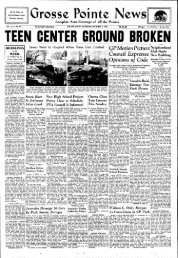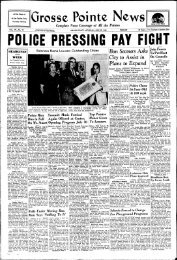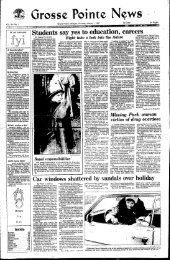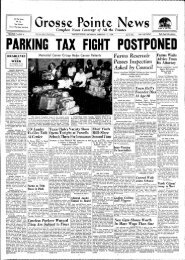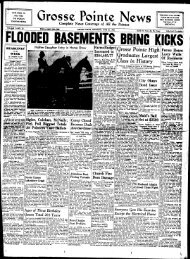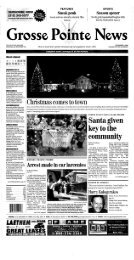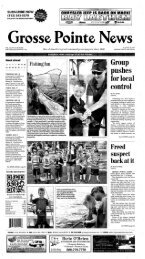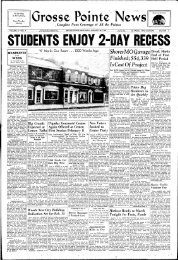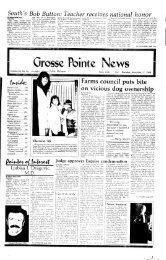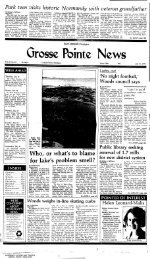Create successful ePaper yourself
Turn your PDF publications into a flip-book with our unique Google optimized e-Paper software.
Suburbia Today<br />
.. ••••••••• ...<br />
... .. ROUND TABLE 10 .. ..<br />
•••••••••••<br />
PE<br />
Edited by GEORGE FIELDING ELIOT<br />
TODAY'S COMMUTER has plenty of problemsa<br />
survey of conditions all over the country,<br />
made through local papers, leaves no doubt about<br />
that. The wonder perhaps is that w~ manage to<br />
get back and forth as well as we do.<br />
The people who have it the best nowadays, by<br />
their own account, are the ones who are still riding<br />
the rails. Where the standard pattern of the<br />
7:55 a.m.-5:25 p.m. st,;rgc to and from the city<br />
prevails, the towns which still have rail service are<br />
trying hard to hang on to it or to revive it where<br />
it has been discontinued. But rail service for commuters<br />
does not pay; railroads are in b:Jsiness to<br />
make money, which they do by hauling freight.<br />
So the railroads, with few exceptions, want "out"<br />
of the commuter business.<br />
There are other problems for the rail commuter,<br />
too. Congestion at suburban stations is one; on the<br />
Boston and Philadelphia services the railroads are<br />
issuing park-and-ride tickets which help this<br />
problem-at a price. Getting to and from the station<br />
is another problem-usually it means a twicea-day<br />
chauffeuring chore for the little woman, or<br />
a two-car family with Daddy parking }lis jalopy<br />
at the station all day. Then there is the trip te)and<br />
from the office once a man is in the big city. Redwood<br />
City tells us the terminal in San Francisco<br />
averages so far from job locations that it often<br />
takes their commuters longer to get from station<br />
to office than to make the 27-mile rail journey.<br />
Over all hangs the uark cloud of how to make<br />
the railroads go on losing money. This involves<br />
what one of our correspondents calls a deadly<br />
cycle: Poorer service, higher fares, declining patronage,<br />
still poorer service, and so on. Many bus<br />
companies appear to be in much the same spot.<br />
The answer seems to be that if rail service is to<br />
keep the flow of commuters moving, it will have<br />
to be subsidized or wholly maintained, even newly<br />
built, by public funds. When faced with these costs,<br />
there has been much taxpayer re~istance, notably<br />
in California but also around Washington, D.C.,<br />
Atlanta, and Detroit, where large-scale rapid transit<br />
systems are being considered. In the Boston,<br />
i>ittsburgh, and St. Louis metropolitan regions,<br />
some plans include making use of abandoned<br />
tracks anti right of ways which are still available.<br />
But even if adequate rail service were restored .<br />
the trains couldn't provide all the answers now.<br />
With so many industries and offices moving out<br />
of the city, more and more- people would be unablt><br />
to get to work by taking a train direct from<br />
one point to another. They need their cars to fan<br />
out from home to ~he new places of business that<br />
are locatir.g all over the countryside.<br />
Finally, most Americans love automobiles and<br />
prefer to drive themselves to work if they can.<br />
Out of 56 publishers reporting from all over the<br />
country, two-thirds said that commuting by car<br />
was the method of choice ili the towns they cover<br />
-and they speak for hundreds of thousands of<br />
commuters.<br />
Most often, it is one man to one car<br />
(have you ever driven into Detroit on Woodward<br />
Avenue on a weekday morning between 8 and<br />
9?), so it's a twiceMa-day"bump and grind," mile<br />
after fumillg mile, to say nothing of the expense<br />
and trouble of arranging for all-day parking in<br />
the choked city. And while the volume of traffic<br />
grows, new road building lags well behind. Total<br />
motor-vehicle registration in the United State:><br />
rose 50%, 1950 to 1960; mileage of surfaced<br />
roads rose only 3-3Y3% .<br />
THE JAM-UPS are real, and they seem likely<br />
to continue. From Richfield, Minnesota, we<br />
hear that "heroic police work reduces a colossal<br />
problem to one ..that is merely tremendous" on a<br />
twice-a-day, five-days-a-week basis. Two cars per<br />
family is standard equipment in many places.<br />
Group riding, popular during wartime when gas<br />
was in short supply. is still used, but sparingly.<br />
Grayslake, Illinois, among other places, reports<br />
that groups of riders will sometimes buy a special<br />
car which they use just for commuting. From<br />
points as far apart as La Grange Park, Illinois,<br />
and Los Gatos, California, complaints are registert~d<br />
(presumably of feminine origin) that the<br />
strains and stresses of the daily struggle on the<br />
freeway result in increased martini consumption<br />
before dinner can be served.<br />
Delays due to weather conditions are noted<br />
in many reports as adversely affecting commutation<br />
by car. From Buechel, Kentucky, we hear<br />
of "Operation Snow," a plan by the mayor of<br />
Louisville in which business firms stlligger working<br />
hours during bad-weather periods, so no peak<br />
volume of traffic is reached during the day.<br />
There is no one answer that fits all the situations,<br />
but when you get d(lwn to cases there are<br />
some bright spots.<br />
Conside! the two happy Barringtons-Rhode<br />
Island and Illinois. Barrington, Rhode Island, has<br />
good, fast motor roads to Providence, also waterways<br />
to the city which are open for use all through<br />
the fair-weather months, and a helicopter service<br />
is coming up for executives of a plant which has<br />
moved into the country. Barrington, Illinois, is<br />
on the Chicago & North Western, one of the few<br />
railroads which do a good job for commuters<br />
and still manage to break even, by using<br />
freight-hauling diesel locomotives for commuter<br />
service in between long-distance freight runs.<br />
T A GRANGE PARK, ILLINOIS, speaKs well of !he<br />
L Burlington's service; the Southern Pacific<br />
gets a pat on the back from Redwood City, California;<br />
and Somerville, New Jersey, has a love affair<br />
with the Jersey Central, which is shared by other<br />
communities along tha~ line.<br />
Many of the publishers we queried feel that new<br />
freeways are the best answer for their local jams,<br />
and certainly they will help absorb some of the<br />
pressure, especialIy as more employment opens<br />
up in the suburbs; making a more flexible pattern<br />
and reducing congestion on the road net that centers<br />
on the city. Yet from Shaker Heights, Ohio,<br />
which has a fine rapid-transit line right into downtown<br />
Cleveland, we hear that "all the eastern suburbs<br />
are now battling to prevent the building of<br />
unwanted, unneeded freeways by the county engineer,<br />
that would butcher the communities these<br />
freeways would profess to serve. We prefer our<br />
lakes, homes, and woodlands to concrete ribbons<br />
which are proposed just because Federal funds<br />
are available to take care of 90% of the cost."<br />
8 Suburbia Today. <strong>Jun</strong>e /964<br />
> -' f , .,<br />
•<br />
{.,\ r -



